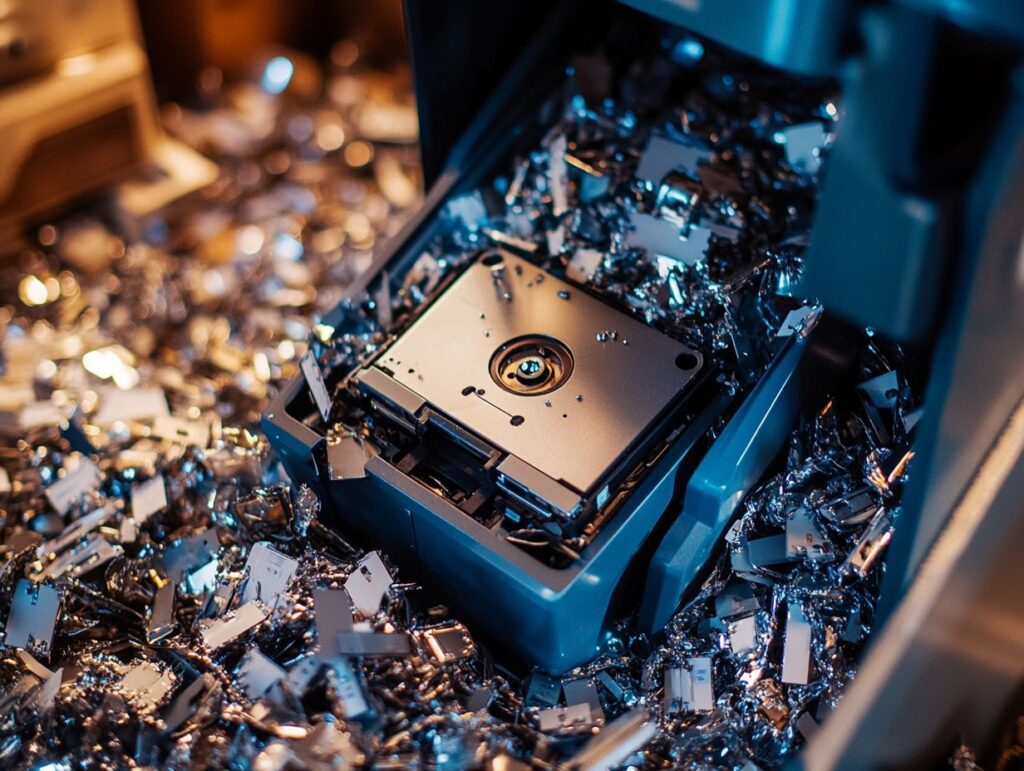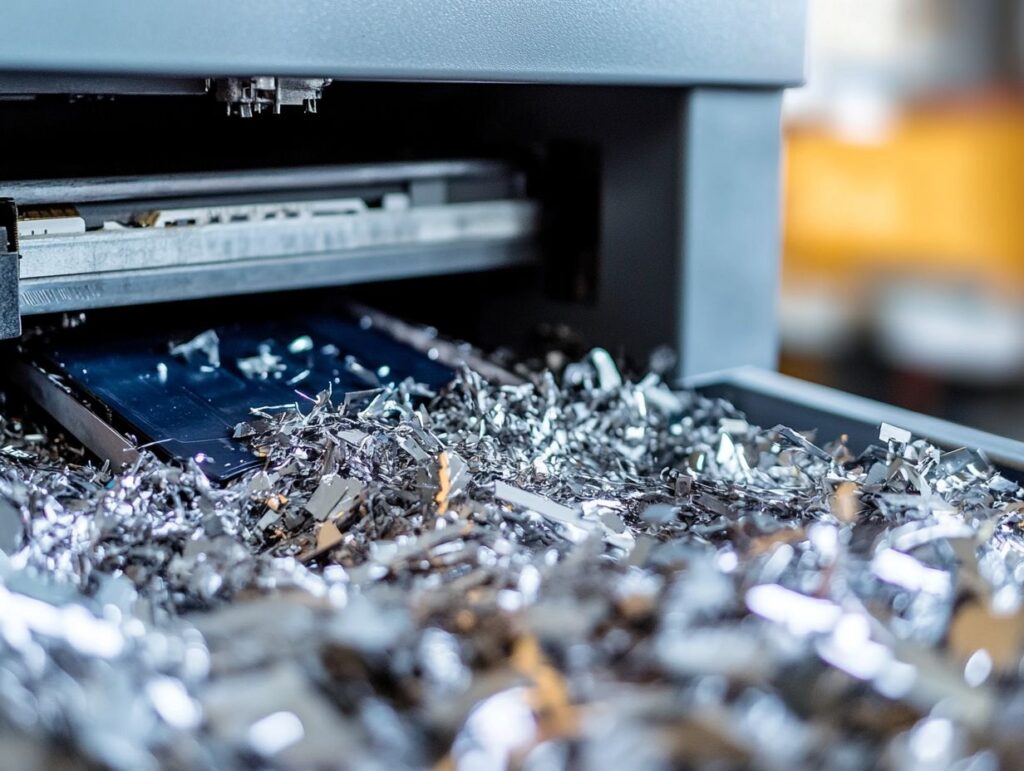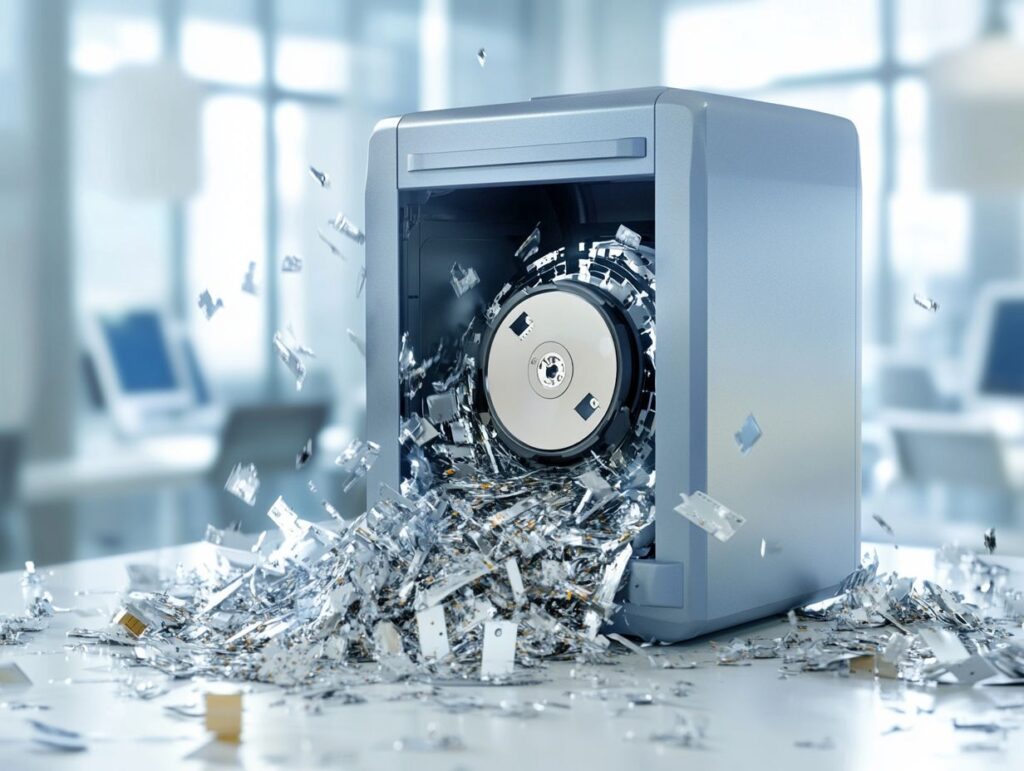In an era where data breaches are alarmingly common, ensuring the secure disposal of sensitive information has never been more critical.
Hard drive shredding is a vital process that protects your data and complies with legal requirements.
This article explores the reasons behind hard drive shredding, including data security and device end-of-life, as well as the best methods for destruction.
Whether you’re a business owner or an individual, understanding when and how to shred your hard drives can safeguard your information.
Join us as we uncover essential insights into effective data destruction practices.
What is Hard Drive Shredding?

Hard drive shredding is a crucial process involving the physical destruction of hard drives to ensure that sensitive information and personal data are permanently irretrievable. This method is essential in the contemporary digital landscape, as it significantly mitigates the risk of data breaches and identity theft, thereby enhancing data security for both individuals and organisations.
The shredding process not only eliminates the hard drive but also plays a vital role in compliance with data privacy regulations, making it an essential practice for businesses that handle sensitive information.
By employing advanced data destruction methods, such as hard drive shredding, organisations can guarantee that confidential documents, customer records, and proprietary information are entirely eradicated. This proactive approach not only protects against unauthorised access but also reflects a commitment to ethical practices in data management.
Environmentally conscious shredding services often emphasise the recycling of shredded materials, contributing to sustainability efforts. This dual focus on security and environmental responsibility highlights the critical importance of hard drive shredding in today’s eco-aware society.
Reasons for Hard Drive Shredding
The rationale for hard drive shredding is multifaceted, encompassing data security, compliance with legal obligations, and the prevention of identity theft. As organisations accumulate substantial amounts of sensitive information, the risk of data breaches escalates, necessitating the adoption of rigorous data destruction practices.
Shredding hard drives ensures that both personal and business data are rendered irretrievable, thereby safeguarding data privacy and ensuring adherence to regulatory requirements. Additionally, this practice supports the responsible management of electronic waste, aligning with objectives related to environmental sustainability.
Data Security and Compliance
Data security and compliance are essential elements of hard drive shredding, ensuring the protection of sensitive records from unauthorised access and potential misuse.
This relationship becomes increasingly significant as organisations navigate the complex landscape of legal obligations related to data retention. By implementing stringent data destruction policies that require the shredding of outdated devices, entities can not only meet compliance requirements but also strengthen their defences against potential data breaches.
Regular audits are often conducted to assess adherence to these policies, highlighting the importance of proactive measures in safeguarding personally identifiable information. Consequently, establishing a comprehensive shredding procedure not only aligns with regulatory mandates but also enhances organisational credibility and trust among clients and stakeholders.
End of Life for Devices
The end-of-life phase for devices presents a critical opportunity for the responsible disposal of IT assets, particularly in the context of managing electronic waste. As organisations upgrade technology and accumulate obsolete hardware, it is imperative to establish effective data lifecycle management practices to ensure the secure disposal of sensitive information.
Hard drive shredding serves as a fundamental component of this process, providing a reliable method for eliminating data vulnerability and ensuring that both personal and business information are no longer accessible.
The volume of electronic waste generated is substantial, making it essential for companies to implement responsible disposal methods that comply with environmental regulations. By developing a comprehensive IT asset management strategy, organisations can mitigate risks associated with data breaches while also contributing to sustainability initiatives.
Recognising the importance of recycling components, refurbishing usable parts, and collaborating with certified e-waste recyclers is essential. This holistic approach not only safeguards sensitive information during the disposal process but also promotes a circular economy, transforming potential waste into valuable resources.
When to Shred a Hard Drive

Determining the appropriate timing for shredding a hard drive is essential for effective data destruction, ensuring that sensitive information is safeguarded against unauthorised access and potential data breaches.
Organisations should assess the risks associated with data recovery and establish a timeline for shredding in accordance with their data retention policies and compliance requirements.
Conducting regular evaluations of data access controls and maintaining an audit trail can assist organisations in making informed decisions regarding the initiation of secure disposal practices.
Key Times for Data Destruction
Key opportunities for data destruction include the conclusion of a data retention policy period, prior to hardware disposal, and in response to a data breach event. Organisations must adopt a proactive approach to data management by implementing a comprehensive risk management strategy that identifies when data becomes obsolete or vulnerable. Shredding hard drives at these critical points not only ensures compliance with regulatory requirements but also mitigates the risk of identity theft and data misuse.
Any phase involving the transition of sensitive data, such as mergers or acquisitions, mandates hard drive shredding to eliminate the risk of unintentional exposure. Regular audits of data storage systems can reveal obsolete materials that require destruction, ensuring that outdated information does not persist and become a target for cybercriminals.
Adhering to established data security protocols is equally vital, as neglecting these measures may result in legal ramifications and damage to an organisation’s reputation. Consequently, the timely destruction of data through shredding serves as a crucial component of an effective risk management plan, establishing a robust frontline defence against potential breaches.
Methods of Hard Drive Shredding
Numerous methods of hard drive shredding are available, each designed to address the requirements of data sanitisation and to ensure that sensitive information is rendered completely irretrievable. The primary techniques include physical destruction, degaussing, and overwriting, with each method serving specific functions within the realm of data recovery and security.
Organisations must select the appropriate shredding method based on their individual data destruction policies, compliance mandates, and security protocols.
Physical Destruction
Physical destruction is regarded as one of the most effective methods of hard drive shredding, ensuring that data cannot be recovered or accessed once the process is complete. This approach typically involves shredding the hard drive into small fragments, rendering the storage medium unusable and safeguarding sensitive information from unauthorised access. Organisations that prioritise data security often incorporate physical destruction as a key component of their secure disposal strategies.
The process generally utilises specialised shredders designed specifically for electronic devices, capable of pulverising hard drives and other storage media into minute pieces, thereby eliminating any possibility of data retrieval.
The benefits of employing shredding equipment extend beyond mere data security; they also encompass compliance with various regulations pertaining to data protection and environmental sustainability.
With robust machinery adept at handling different types of drives, including solid-state drives (SSDs) and traditional hard disk drives (HDDs), the physical destruction method is both effective and comprehensive.
Proper execution of this method not only ensures complete irretrievability of data but also provides peace of mind, as it guarantees the permanent eradication of sensitive information.
Degaussing

Degaussing is a method of hard drive destruction that employs powerful magnets to disrupt the magnetic fields of storage devices, effectively erasing all data. This technique is particularly beneficial for organisations that require stringent data sanitisation methods to prevent data recovery. By rendering the data on hard drives unrecoverable, degaussing plays a critical role in maintaining data security and ensuring compliance with relevant standards.
In an age where information security breaches can have severe repercussions, understanding the appropriate circumstances for implementing degaussing is essential. It is advisable for organisations that handle highly sensitive data, such as financial institutions or healthcare providers, to incorporate this effective technique into their overall data destruction strategy. This process not only serves as a reliable means of hard drive destruction but also enhances comprehensive data sanitisation practices.
By ensuring that data cannot be retrieved, organisations can significantly mitigate the risk of unauthorised access and strengthen their defences against potential data breaches.
Overwriting
Overwriting is a data deletion method that entails writing new data over existing information on a hard drive to prevent data recovery. When executed correctly, this technique serves as an effective means of safeguarding data security, significantly reducing the potential for unauthorised access to sensitive information.
Organisations must ensure that the overwriting process is comprehensive to guarantee complete data destruction, rendering it an essential component of their secure data handling procedures.
Comprehending the best practices for overwriting is vital for any organisation aiming to protect its data. This includes implementing multiple overwrite passes, which enhance the method’s effectiveness by making it considerably more challenging for even the most determined data recovery specialists to retrieve any remnants of the original data.
Adhering to established data destruction protocols is critical, as these guidelines provide a structured framework that underscores the importance of maintaining compliance with industry standards. Furthermore, utilising advanced overwriting software can substantially bolster data security, providing an additional layer of assurance against potential breaches and ensuring that sensitive information is irretrievably lost.
Choosing a Hard Drive Shredding Service

Selecting a reputable hard drive shredding service is crucial for organisations aiming to ensure the secure disposal of their data-bearing assets. Companies should assess prospective service providers based on their credentials, shredding equipment, and compliance with relevant audits to guarantee that sensitive information is managed appropriately.
A distinguished shredding service not only safeguards data but also plays a vital role in the overall data governance strategy of the organisation.
Factors to Consider
When selecting a hard drive shredding service, it is imperative to consider several factors to ensure data security and compliance with established protocols. Organisations should assess the credentials of service providers, inquire about their shredding processes, and verify adherence to relevant security protocols and compliance requirements. Maintaining an established audit trail and chain of custody is essential to uphold accountability throughout the data destruction process.
These critical factors are pivotal in safeguarding sensitive information and upholding data governance principles. Organisations must thoroughly scrutinise the security measures implemented by shredding services, ensuring they adhere to stringent guidelines for secure data handling. It is essential to evaluate whether the service provider employs state-of-the-art shredding technology and maintains a controlled environment throughout the procedure.
A robust chain of custody not only mitigates the risk of potential data breaches but also provides reassurance by ensuring that every step of the shredding process is documented and verifiable. This comprehensive evaluation ultimately strengthens organisational security, reduces vulnerability, and ensures compliance with industry regulations.
Frequently Asked Questions
Why is it important to shred a hard drive?
Shredding a hard drive ensures that all confidential data is permanently erased, preventing it from falling into the wrong hands and reducing the risk of identity theft or data breaches.
What are the key times for data destruction?
The key times for data destruction include when a hard drive is no longer needed, when upgrading to a new computer, when disposing of old equipment, when leaving a job or organisation, and when closing a business.
When should I shred a hard drive when leaving a job?
If you are leaving a job, it is important to shred your hard drive before leaving to ensure that any sensitive company data is properly disposed of and cannot be accessed by others.
Is it necessary to shred a hard drive before disposing of old equipment?
Yes, it is necessary to shred a hard drive before disposing of old equipment. Simply deleting files or formatting the drive is not enough to completely erase the data and protect sensitive information.
Can I shred a hard drive myself or should I use a professional service?
While you can shred a hard drive yourself, it is recommended to use a professional service. They have specialised equipment and processes to ensure that all data is completely destroyed and cannot be recovered.
How often should I shred a hard drive?
It is recommended to shred a hard drive whenever it is no longer needed or before disposing of old equipment. It is also a good idea to regularly review and shred old hard drives to prevent any potential data breaches.

